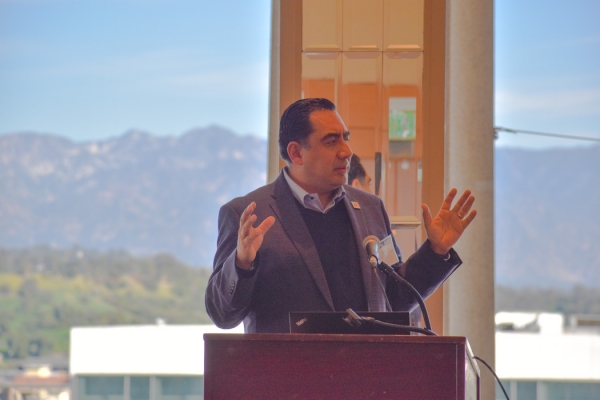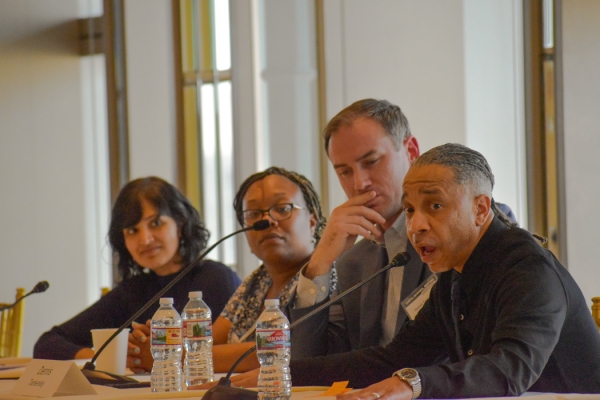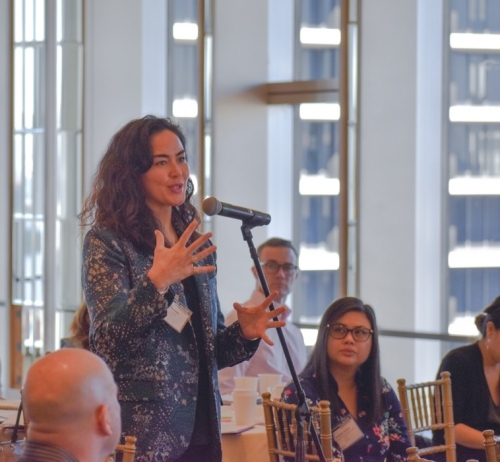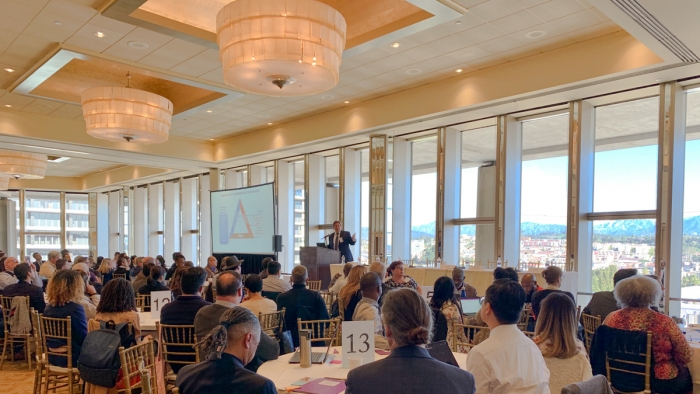The preliminary report for this project is now available! Learn more and access the report on our website here.
January 24th, 2020- 150 community stakeholders, leaders, and county representatives attended the CHIPTS regional response meeting to end the HIV epidemic in CA on Friday, January 24th, 2020 from 8AM-4:30PM at the LA Music Center’s Dorothy Chandler Pavilion.
The meeting aimed to:
- Gather ideas, feedback, and consensus from counties on collaborative opportunities to support Ending the HIV Epidemic Initiative’s (EHE) efforts
- Identify resources, capacity building, and infrastructure needs to support these collaborations
- Identify research and policy questions to support counties in the implementation of best practices and strategies to reach the EHE goals
Steve Shoptaw, Director of CHIPTS, beg an the morning with an overview of the day’s mission, highlighting examples of regional issues capable of being supported by the four EHE pillars and mentioning potential opportunities for regional/structural connections. The morning session then proceeded with two panel discussions orchestrated around presentations from federal and state government officials, alongside leaders from 8 targeted EHE counties. Federal and state perspectives were given by Harold Phillips from Health and Human Services (HHS), Christopher Gordon from the National Institute of Mental Health, Paul Weidle from the Center for Disease Control and Prevention (CDC), Captain John Moroney from Health Resources and Services (HRSA), Michelle Sandoval-Rosario from PACE, Benjamin Ayers from the US Department of Housing and Urban Development (HUD), and Andrew Forsyth from the California HIV/AIDS Research Program. In aiming to identify gaps and build bridges for regional coordination, Kevin Sitter of the State Office of AIDS moderated the panel discussion with county representatives Mario Perez from LA County Division of HIV and STD programs (DHSP),
an the morning with an overview of the day’s mission, highlighting examples of regional issues capable of being supported by the four EHE pillars and mentioning potential opportunities for regional/structural connections. The morning session then proceeded with two panel discussions orchestrated around presentations from federal and state government officials, alongside leaders from 8 targeted EHE counties. Federal and state perspectives were given by Harold Phillips from Health and Human Services (HHS), Christopher Gordon from the National Institute of Mental Health, Paul Weidle from the Center for Disease Control and Prevention (CDC), Captain John Moroney from Health Resources and Services (HRSA), Michelle Sandoval-Rosario from PACE, Benjamin Ayers from the US Department of Housing and Urban Development (HUD), and Andrew Forsyth from the California HIV/AIDS Research Program. In aiming to identify gaps and build bridges for regional coordination, Kevin Sitter of the State Office of AIDS moderated the panel discussion with county representatives Mario Perez from LA County Division of HIV and STD programs (DHSP),
 Cynthia Turk from San Bernardino County Department of Health, Natalie Silva from Orange County Health Care Agency, Lea Morgan from Riverside University Health System, Patrick Loose from San Diego County HIV, STD, and Hepatitis Branch of Public Health Services, and Hanna Hjord from San Francisco County Department of Public Health, who presented alongside Bill Blum.
Cynthia Turk from San Bernardino County Department of Health, Natalie Silva from Orange County Health Care Agency, Lea Morgan from Riverside University Health System, Patrick Loose from San Diego County HIV, STD, and Hepatitis Branch of Public Health Services, and Hanna Hjord from San Francisco County Department of Public Health, who presented alongside Bill Blum.
The afternoon session proceeded onwards with four panel discussions underscoring successes and potential new opportunities for regional responses to eliminate HIV transmission. Accomplishments from counties with existing collaborations were shared by Erica Washington from AIDS Healthcare Foundation, Jadawn Wright from the Pacific AIDS Education and Training Center (PAETC), and Aunsha Hall-Everett from the California Prevention Training Center. The following three panels focused on strategies specific towards each of the four EHE pillars: Diagnose, Treat, Prevent, and Respond.

Tom Donohoe of the LA AIDS Education and Training Center (LAAETC) moderated the panel for the Diagnose and Treat Pillars, with presentations for methods to increase screening, early treatment, and sustained viral suppression given by  Erica Washington, Sonali Kulkarni from LA County DHSP, and Weyman Edwards and Dennis Tankersley from San Bernardino County Arrowhead Regional Medical Center. Pamina Gorbach of UCLA CHIPTS moderated the panel for the Respond Pillar, which included Philip Peters from the State Office of AIDS, Ryan Murphy from the STD Control Branch, Andrea Kim from LA County DHSP, and Patrick Loose who shared insight on enhancing data system coordination to more rapidly respond to outbreaks and better inform service planning. Lastly, Steve Shoptaw facilitated the panel for the Prevent Pillar. Panelists Gabriel Maldonado from TruEvolution, Luckie Alexander from Invisible Men, Lello Tesema from Substance Abuse Prevention and Control, and Mark Casanova from Homeless Health Care Los Angeles gave specific focus to understanding tools that may help increase PrEP, syringe service programs, and other proven interventions.
Erica Washington, Sonali Kulkarni from LA County DHSP, and Weyman Edwards and Dennis Tankersley from San Bernardino County Arrowhead Regional Medical Center. Pamina Gorbach of UCLA CHIPTS moderated the panel for the Respond Pillar, which included Philip Peters from the State Office of AIDS, Ryan Murphy from the STD Control Branch, Andrea Kim from LA County DHSP, and Patrick Loose who shared insight on enhancing data system coordination to more rapidly respond to outbreaks and better inform service planning. Lastly, Steve Shoptaw facilitated the panel for the Prevent Pillar. Panelists Gabriel Maldonado from TruEvolution, Luckie Alexander from Invisible Men, Lello Tesema from Substance Abuse Prevention and Control, and Mark Casanova from Homeless Health Care Los Angeles gave specific focus to understanding tools that may help increase PrEP, syringe service programs, and other proven interventions.
Each of the panel sessions was composed of inclusive representation at different levels, sectors, and counties, all in all emphasizing the importance of having community engagement and involvement. Questions, concerns, and suggestions were also voiced by attendees throughout the day, with  written feedback accounted for each of the EHE Pillars (Diagnose, Treat, Respond, and Prevent).
written feedback accounted for each of the EHE Pillars (Diagnose, Treat, Respond, and Prevent).
Participant feedback showed a strong enthusiasm for the opportunity to learn from and network with the diverse group of HIV stakeholders at this meeting, and a strong desire to stay connected. In their comments, participants most commonly identified the need for an infrastructure to continue to support cross-jurisdictional collaboration, communication, and/or data sharing.
Expected outcomes of this meeting will include the following:
- Summary report that will be shared with attendees
- Follow-up with counties to support development of ideas, to facilitate connections, and to identify resources to build and sustain regional response to HIV
- CHIPTS to work to sustain initial efforts and continue regional response (e.g. find funding, establish or build on regional working groups).
The meeting agenda and presentation slides are available for download below. Videos of each presentation are available on our YouTube channel, and linked at the bottom of this page. Visit the CHIPTS Facebook page for a mini gallery of the event.
A Regional Response to End the HIV Epidemic in California - AgendaEnding the HIV Epidemic: A Plan for America - Slides
CDC: A Regional Response to End the HIV Epidemic in America - Slides
HRSA: Ending the HIV Epidemic: A Plan for America - Slides
Prevention through Active Community Engagement Program - Slides
US Department of Housing and Urban Development: We Cannot end the HIV Epidemic in the United States without Housing. - Slides
California HIV/AIDS Research Program: A View from CHRP - Slides
LA County DHSP: Identifying Gaps and Building Bridges for Regional Coordination
San Bernardino DPH: Mobile Rapid Response Team - Slides
EHE Plan: Orange County Health Care Agency - Slides
EHE Plan: Riverside Health System - Slides
San Diego HIV, STD & Hepatitis Branch of Public Health Services - Getting to Zero - Slides
Ending the HIV/ HCV/ STI Epidemics Plan - Slides
Regional Approach to Using Molecular HIV Data - Slides
Adapting Data Systems to Support Integrated STD/HIV Field Investigations at the Local Level - Slides

